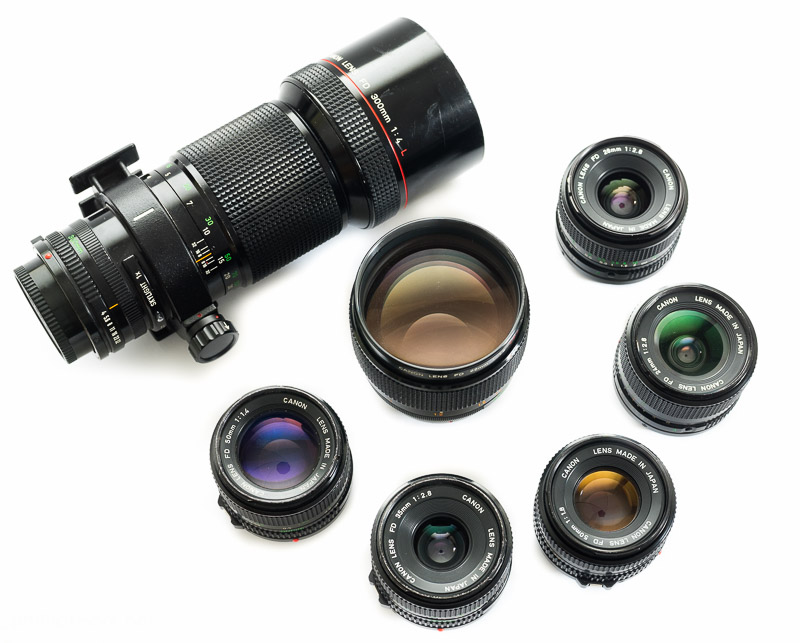
Introduction
This guide was written to give you a good idea what to expect from Canon’s older FD lenses, many of which still perform very well on modern digital cameras.
All tests are performed with the 24MP full frame Sony a7/a7ii. Our ratings are always based on using the lenses with these cameras, the evaluation will be a different one on a smaller sensor. To learn more about using manual lenses on the Sony a7 check our beginners guide.
Most of these summaries are based on our own experience but we also decided to also include lenses we haven’t used ourselves to pool useful information we found on the net which we have summarized based on our experience with reviewing lenses. We would also be very happy if you shared your own experience with Canon FD lenses we don’t have any reliable information on yet. We are quite picky with the information we use though. That’s because 95% of the information we come across is unreliable: Everyone has different standards, Person A might rate the very same lens as a great performer while person B thinks it’s total junk. So we are mostly interested in full resolution images taken with a fullframe camera including information on the aperture used.
If you purchase the lens through one of the affiliate-links in this article we get a small compensation with no additional cost to you.
Contents
Wideangle lenses
Canon (n)FD 4/17
Status: Used by Jannik for a short time in the past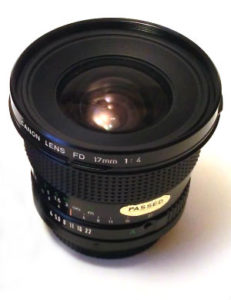
- At f/4 the center is quite good but…
- … I’d recommend to stop down to f/11 for usable sharpness across the frame although it never gets tack sharp, partially because of the very strong lateral CA.
- Very low distortion (the biggest quality of this lens, especially in the film era), bad flare resistance and 6-bladed aperture.
- Medium size, and average price/performance ratio.
- The age of this legacy lenses shows clearly when it iscompared to modern options. Nevertheless, it is pretty usable if you give the files some love in the post processing (remove CA’s and sharpening).
360g + adapter | $200 | technical data | sample images | user reviews
buy from ebay (affiliate link)
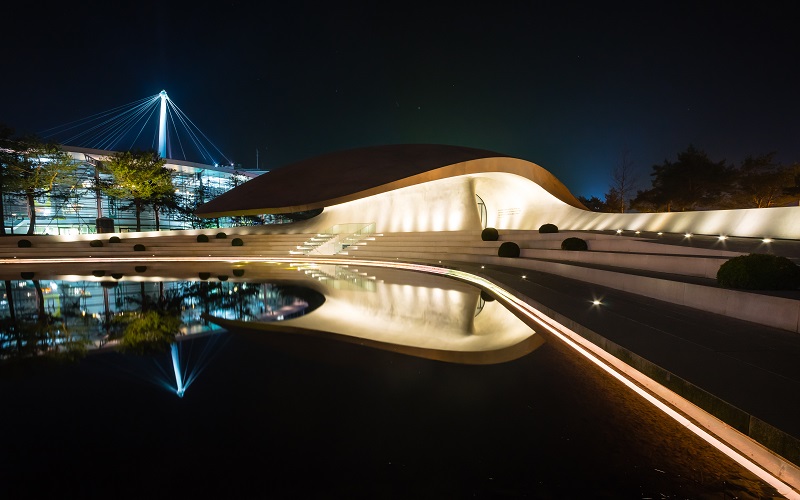
Canon (n)FD 2.8/20
Status: Used a lot by Phillip then sold to fund the FE 4/16-35. Owned by Jannik for a short time, but replaced by the Loxia 2.8/21.
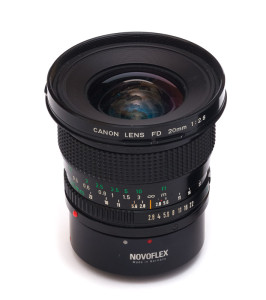
- At f/2.8 the center of the image is sharp but quite strong vignetting, busy bokeh, strong coma and soft corners limit the usefulness of this aperture.
- From f/5.6 it is good across the frame, very good at f/8 and for the very good corner performance you should stop down to f/11.
- Some mustache distortion and average flare resistance, the filter thread rotates which is annoying for polarizer use.
- Medium size and weight. Good price/performance ratio.
I can recommend this lens to anyone who needs an affordable solution for landscape photography but make sure to stop it down.
305g | $160 | full review | aperture series | sample images
buy from ebay (affiliate link)
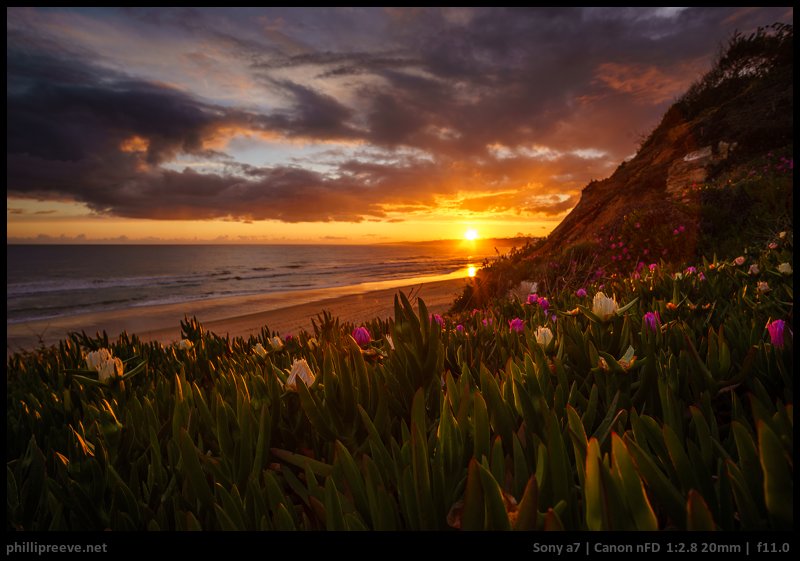
Canon nFD 2/24
Status: Phillip owned it for a short time back in the Nex-days, some reliable information available.
- Quite soft wide open
- Performance seems to be a tiny little bit better than that of the nFD 2.8/24 at the same aperture
- Quite expensive, especially because this lens suffers from dissolving bearings which cause significant play in the focusing ring so be very careful if you want to buy one.
- Remarkably light if you consider that the one stop slower nFd 2.8/24 is just 45g less.
It is a good lens but the only significant difference to the f/2.8 version is that it is a stop faster and it isn’t very good at f/2 so the much cheaper 2.8/24 is the smarter buy if you ask me.
285g | $200 | technical data | Review | short review | test images Nex-5n
buy from ebay (affiliate link)
Canon nFD 2.8/24
Status: Reviewed by Phillip who still uses it occasionally.
 Noticeable vignetting, busy bokeh, some coma and soft corners at f/2.8. The center is sharp.
Noticeable vignetting, busy bokeh, some coma and soft corners at f/2.8. The center is sharp.- Very good performance across the frame at f/8 and f/11.
- Moustache distortion and mediocre flare resistance.
- Quite small and light, excellent price/performance ration.
A very good solution for budget oriented landscape shooters, it is small, cheap and sharp.
240g | $65 | full Review | aperture series | sample images
buy from ebay (affiliate link)
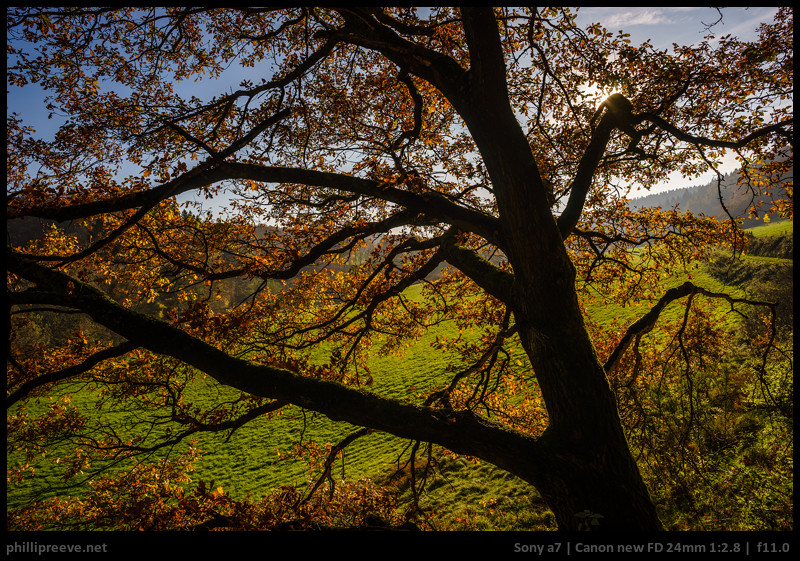
Canon nFD 2.8/28
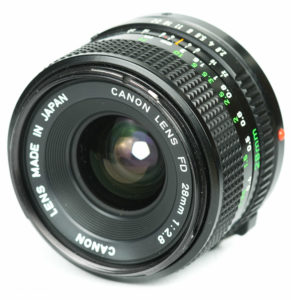 Status: Owned by Phillip for a few weeks.
Status: Owned by Phillip for a few weeks.
- If you accept some funky bokeh f/2.8 is usable with good central sharpness and acceptable vignetting.
- At f/8 it is very sharp across the frame but the extreme corners are soft.
- Decent flare resistance, sadly only 5 aperture blades.
- Very low size and weight. Great price/performance ratio.
If you consider the price this a very attractive lens, not only for landscape photography but also other genres because it is quite usable wide open.
170g | $35 | technical data | aperture series | sample images
buy from ebay (affiliate link)
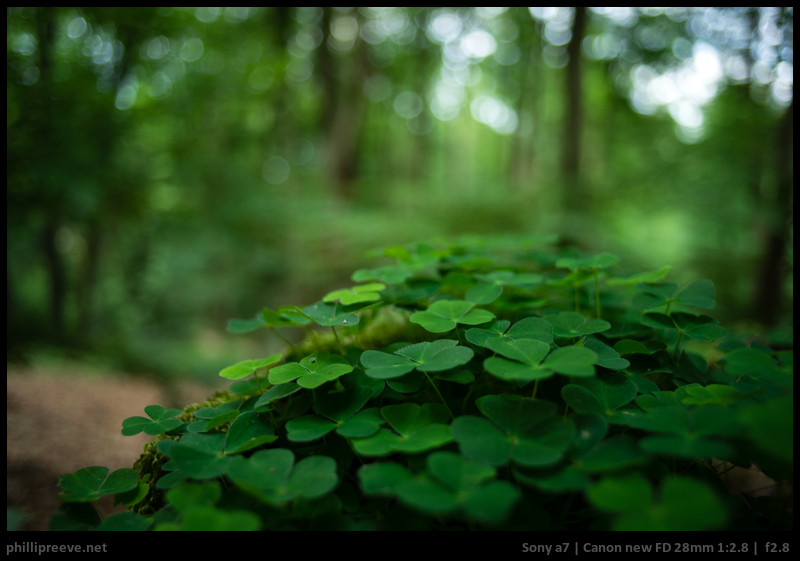
Canon nFD 2.0/35
Status:
- At f/2 the center is sharp, and there is some vignetting. Corners are soft.
- From f/8 it is very good across the frame.
- Some barrel distortion and decent flare resistance.
- Rather low size and weight. Good price/performance ratio.
- Best bokeh of all FD 35mm lenses, 8 aperture blades.
- Excellent close-up-performance and good minimum focusing distance
- Can have issues with the bearings.
All in all the most balanced FD 35mm lens. Recommended.
245g | 120€ | comparison
buy from ebay* |(affiliate link)
Canon FD 2/35 (convex)
Status: Borrowed by Phillip for a few weeks, some reliable information available.
- At f/2 it is sharp in the center with little CA, bokeh is decent and vignetting quite noticeable.
- From f/5.6 good across the frame sharpness.
- I can’t judge the flare resistance.
- Solid build quality but also rather large and heavy for a 35mm lens. Good price/performance ratio.
- There is also an older, optically different version of this lens with the smallest aperture of f/16 (not f/22) and a concave front element which is radioactive.
All in all an attractive lens with a wide range of applications an good performance in most aspects, a little on the heavy side.
370g | $130 | noland.photos short review | aperture series | sample images
buy from ebay* (affiliate link)
Canon nFD 2.8/35
Status: Owned by Phillip for a few months.
- At f/2.8 most of the image is sharp, vignetting is visible, bokeh is decent and coma is not much of an problem so this aperture is fully usable.
- From f/5.6 it is very good across the frame, and improves a little at f/8. It has only 5 aperture blades which affects the bokeh.
- Less sharp at closer distances.
- Some barrel distortion and decent flare resistance.
- Very low size and weight. Great price/performance ratio.
Not only is it small and affordable, it is also quite sharp from f/2.8 with rather smooth bokeh so it is a lens with a wide range of applications.
165g | $50 | full review | aperture series | sample images
buy from ebay* (affiliate link)
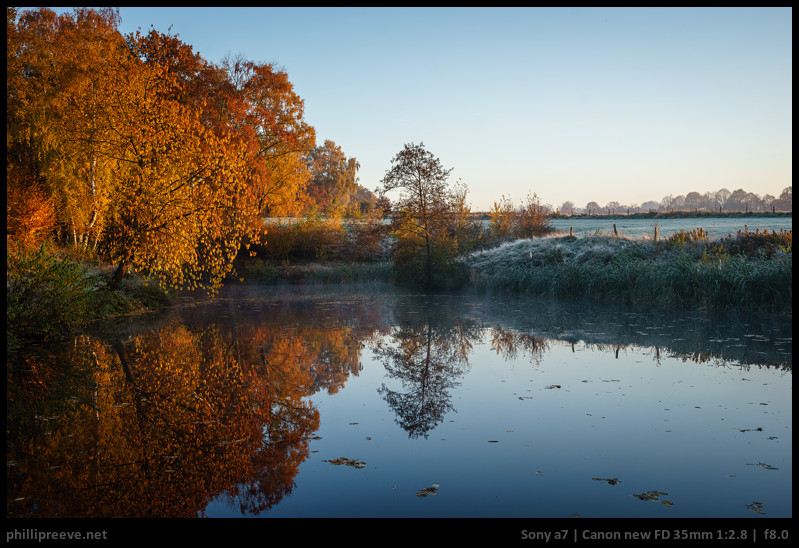
Normal lenses
Canon nFD 1.2/50 L
Status: Never owned ourselves, some reliable information available.
- At f/1.2 very similar performance to the much bigger FD 1.2/55 Aspherical that is moderate resolution in the center but quite good contrast.
- At f/5.6 it is of course excellent in the center but unlike it’s slower (an much cheaper) cousin the 1.4/50 it can’t hold this sharpness to the corners.
- It shows very obvious onion rings.
- Weight and size is a little above average for a 50mm lens but not by much. It is very expensive.
The red L-ring is of course alluring and it’s contrast at f/1.2 was unrivaled back in the day but I wouldn’t be willing to pay $600 for this lens when a lens like the not much more expensive Sigma 1.4/50 plays in a totally different league.
380g | $600 | MTF Diagram (scroll down) | comparison with 1.2/55 Asph. and 1.4/50 | comparison with FE 1.8/55
buy from ebay (affiliate link)
Canon nFD 1.4/50
Status: Phillip has reviewed it and uses it occasionally.
- The nFD version is slightly better optically and noticably smaller and lighter than it’s FD precedessor which is more solid.
- At f/1.4 it is sharper than most other 50mm lenses but even in the center contrast is a bit muted, the resolution is fine though and the corers are lousy. Vignetting is very obvious, bokeh is on the busy side and coma very high. So you can use f/1.4 but most often it makes sense to stop down to f/2 where contrast, sharpness and bokeh are much better.
- From f/5.6 it is spectacular, only the corners improve a little at f/8.
- Low barrel distortion, strong vignetting at f/1.4 and average flare resistance.
- Low size and weight. Great price/performance ratio.
A versatile lens which changes it’s character completely as you stop down. It is somewhat soft wide open but excellent stopped down. It is small, fast and affordable so I can only recommend it.
235g | $50 | full review | aperture series | sample images | MTF Diagram (FD Version)
buy from ebay (affiliate link)
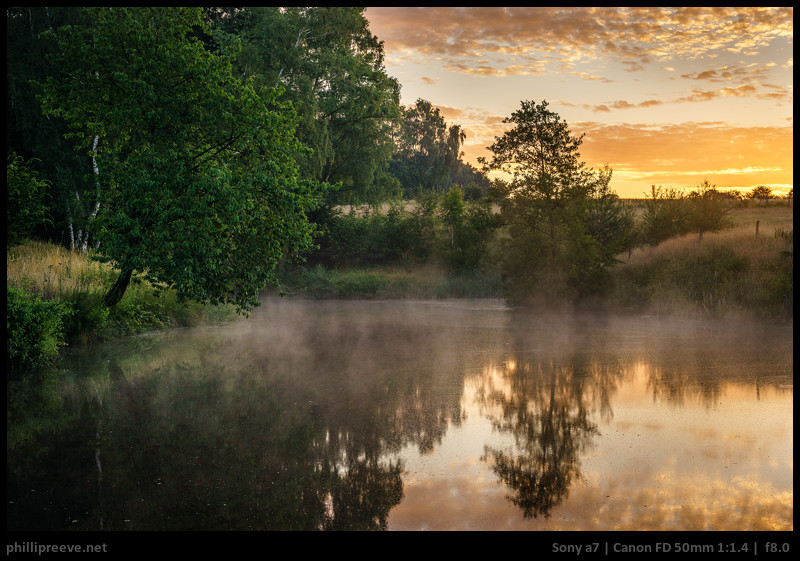
Canon nFD 1.8/50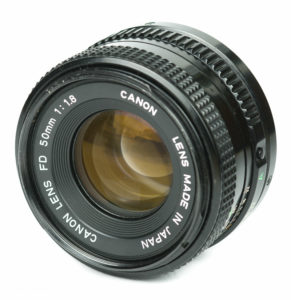
Status: Owned by Phillip for a few months, doesn’t see much use.
- At f/1.8 it has good resolution but quite low contrast, high vignetting and busy bokeh, from f/2.8 it is excellent in the center but the corners stay soft.
- From f/5.6 it is truly excellent across the frame.
- It has simpler coatings and is quite susceptible to flare. It als has only 5 aperture blades and the close focusing distance is 0.6m.
- Very low size and weight. Excellent
price/performance ratio.
It isn’t a bad lens but the nFD 1.4/50 is a significantly better lens for only a few bucks more so I can’t really recommend this one.
170g | $20 | full review | aperture series | sample images
buy from ebay (affiliate link)
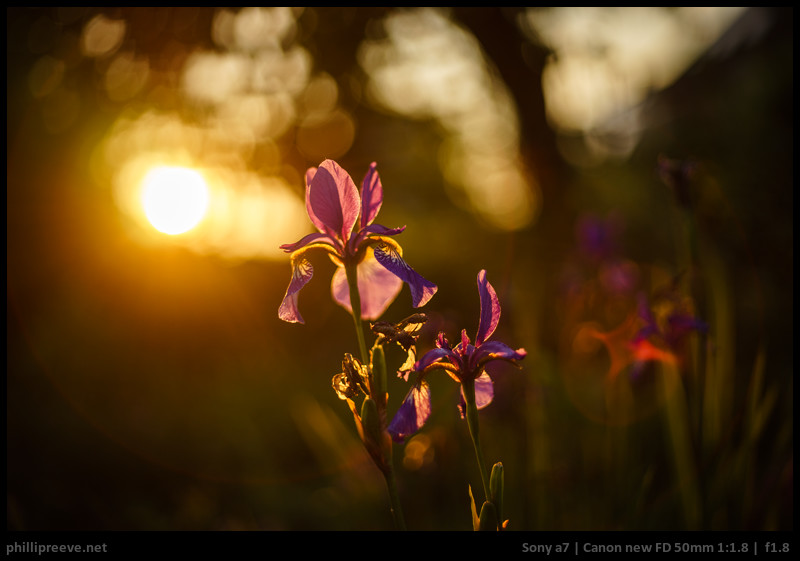
Canon (n)FD 3.5/50 Macro
Status: Never used ourselves, some reliable information available.
- Excellent performance in the center from f/3.5, corners are good enough.
- At f/8 it is very sharp across the frame but it doesn’t quite reach the excellent performance of the infinity optimized faster 50’s.
- Rather strong vignetting wide open
- Small and affordable.
- It only reaches a 1:2 magnification and usually comes with a 25 mm spacer to reach 1:1.
If you need a 50mm macro lens I wouldn’t hesitate to buy this sharp and affordable lens.
230g | $60 |aperture series | sample images | technical data | MTF Diagram | User report (in German)
buy from ebay (affiliate link)
Canon FD 1.2/55
Status: Borrowed from a friend for two weeks, ran one extensive comparison with it.
- Released as FL, later updated to FD, coatings were probably updated.
- At f/1.2 contrast is low and bokeh rather busy but sharpness is surprisingly high. At f/2 contrast is a lot higher and the bokeh smoother.
- At f/8 it is excellent across the frame.
- Big and heavy for a 50mm lens, handling is pleasant and build quality very high. Short focusing distance is high at 0.6m.
I think this is an underrated lens, sure it isn’t small and the bokeh isn’t the smoothest but I was surprised by the sharpness and it is rather affordable compared to other f/1.2’s.
565 g | $150 | Phillip’s images | aperture series
full resolution collection | comparison with Minolta 1.2/58 |sebboh’s images | comparison with other normal lenses at f/8 | flickr pool
buy from ebay (affiliate link)

Canon FD 1.2/55 Aspherical
Status: Never used ourselves, reliable information available.
- At f/1.2 contrast is a higher than that of the nFD 1.4/50 at f/1.2 which is a remarkable performance for such a fast lens sharpness is a bit lower though. Bokeh is quite pleasant without obvious onion rings.
- It features floating elements which – compared to other normal lenses – improves performance at shorter distances quite a lot.
- At f/5.6 there is quite a bit of astigmatism at the edges whereas the nFD 1.4/50 is free from it and therefore superior for landscape images.
- A hlarge, heavy and expensive lens.
All in all it is a good performer for portraits and other stuff where contrast and good central sharpness as well as bokeh matter but not the best choice when off-center sharpness matters and modern lenses like the Mitakon 0.95/50 are probably a better choice.
575g | $650 | full resolution samples images | user report (German) | MTF Diagram (scroll down) | comparison with 1.2/50 L and 1.4/50
buy from ebay (affiliate link)
Canon FD 1.2/85 Aspherical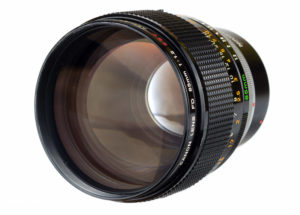
Status: Owned by Jannik for a few months then sold to Phillip who has owned it for a few months.
- At f/1.2, the center has usable sharpness, the midfield and the edges are not sharp. Because of spherical aberrations contrast is quite low but still better than most 1.4/50 lenses wide open. We’d only recommend to use this setting for atmospheric portraits or low-light photography.
- The whole image sharpens up a lot at f/1.6, the center is very good as is the contrast from this aperture.
- The center sharpness peaks at f/2.8, the midfield shows good sharpness but the corners are softer.
- At f/4, the image is excellent, only the extreme corners are just good.
- To get the best corner performance, stop down to f/8.
- The bokeh is smooth at typical portrait distances but gets a bit nervous at longer distances
- Low barrel distortion and bad flare resistance. Make sure to get a hood, it doesn’t need to be the expensive original one.
- Large size and weight, very good built quality
- There is a “L” and a “S.S.C. Aspherical” Version – optically, there is no difference except of an additional aperture blade for the Asperical version, which causes better bokeh stopped down and different sun stars. The current EF version isn’t any sharper.
If you consider that this lens was released 45 years ago it’s performance is absolutely astonishing and it still shines today.
756g | $650 | review | aperture series | MTF Diagram | sample images
buy from ebay (affiliate link)
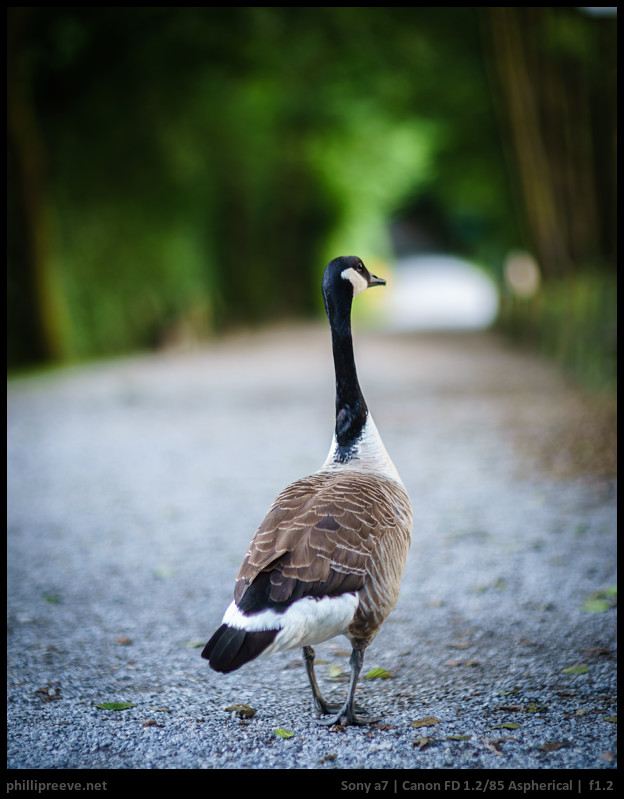
Canon (n)FD 1.8/85
Status: Jannik owned the lens (S.S.C. version) but sold it some time ago.
 Wide open it is already pretty sharp in the center.
Wide open it is already pretty sharp in the center.- From f/2.8 it is excellent in the center.
- Shows some field curvature, especially at short distances. Therefore, corners can appear unsharp.
- Bokeh is pretty decent.
- Axial CA’s are pretty low but not absent
- Light weight and rather small portrait lens. (applies only to the nFD version. The S.S.C. version is much heavier and larger)
- Recommended for portrait work. When it comes to landscape photography, the 2/100mm and the 1.2/85 perform better.
- Average price/performance ratio.
345g | $170 | gallery | user reviews | comparison with 1.2/85 L | flickr group | technical data
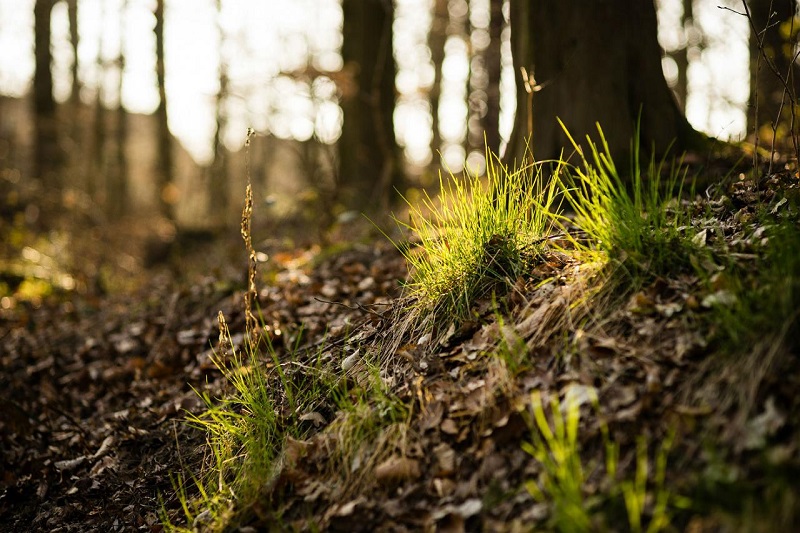
Canon nFD 2.0/100
Status: Jannik owned the lens for some time but sold it.
- At f/2.0, the center is very sharp, the midfield and the edges reach good sharpness. For portraits and shallow depth-of-field work, this is excellent.
- All regions of the frame improve by stopping down to f/2.8. The center is excellent there and doesn’t improve any further. The corners are very good at f/4 and peak at f/5.6.
- Pleasant bokeh, vignetting is present but not really a problem.
- The only issue is a medium amount of CA. How much it affects your image depends a lot on your subject.
- Very low pincushion distortion and average flare resistance.
- Small but pretty heavy, much glass in a small case. Therefore, the writings are on the edge of the barrel.
- Decent price/performance ratio.
- All in all a excellent lens for portraits and for landscape photography. Highly Recommended
445g | ~300€ | aperture series | sample images | user review (German) | user review
Canon nFD 2.0/135
Status: Jannik owned the lens shortly but sold it some time ago.
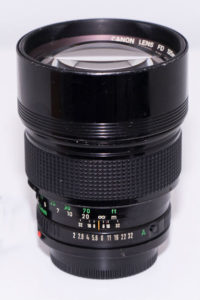 At f/2.0, the center is very sharp, the midfield and the edges reach good sharpness. For portraits and shallow depth-of-field work, this is excellent.
At f/2.0, the center is very sharp, the midfield and the edges reach good sharpness. For portraits and shallow depth-of-field work, this is excellent.- All regions of the frame improve by stoping down to f/2.8. The center is excellent there and doesn’t improve any further. The corners are very good at f/4 and excellent at f/5.6.
- It is sharp across the frame with pleasant bokeh, vignetting is present but not really a problem. The only issue is a medium amount of CA. How much it affects your image depends a lot on your subject: It can be a problematic e.g. when photographing metallic objects or unproblematic e.g. for portraits.
- For best results when shooting landscapes, stop down to f/5.6, the improvement isn’t large but noticeable and vignetting will be all but invisible at this aperture. For portraits, don’t hesitate to shoot it wide open or at f/2.8.
- Very low pincushion distortion and average flare resistance.
- Large size and weight, good built quality.
- Decent price/performance ratio.
All in all a excellent lens for portraits and also good for landscape photography. Highly Recommended
660g | ~300€ | aperture series | sample images | theweekendlens.com review
Canon nFD 2.8/135
Status: Phillip has reviewed it but not used much since then.
- At f/2.8 it is sharp across the frame with pleasant bokeh, vignetting is present but not really a problem. The only issue is CA which is quite strong. How much it affects your image depends a lot on your subject: It can be a problematic e.g. when photographing metallic objects for portraits it is less of an issue.
- For best results stop down to f/5.6, the improvement isn’t large but noticeable and vignetting will be all but invisible at this aperture.
- Very low pincushion distortion and average flare resistance.
- Medium size and weight, average built quality.
- Great price/performance ratio.
All in all a very good lens for portraits and landscape photography for a great price.
398g | $60 | full review | aperture series | sample images
buy from ebay (affiliate link)
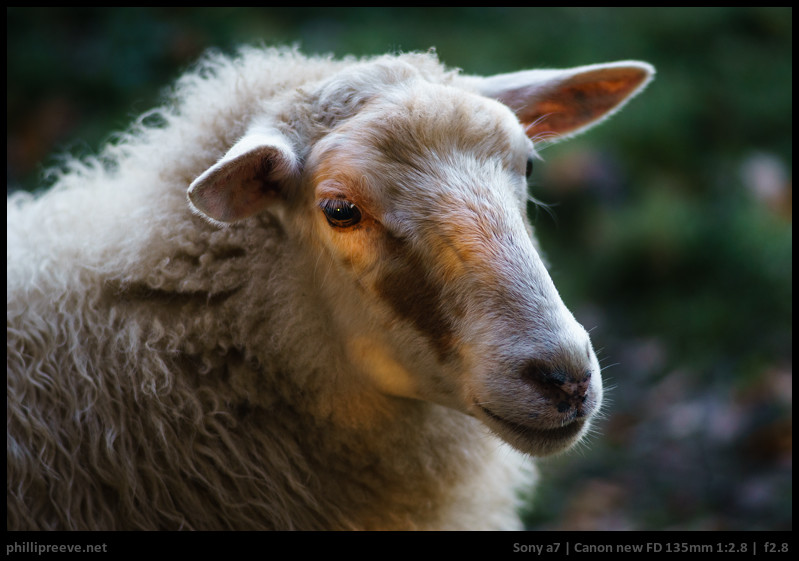
Canon nFD 2.8/200 IF
Status: Never used ourselves, some reliable information available.
- There are two different versions of the nFD 2.8/200 lens, the older one focuses conventionally and has identical optics as the S.S.C. version. The newer one which is a bit smaller focuses internally and has different optics.
- Sharp across the frame from f/2.8 but with a tremendous amount of CA.
- This lens is usually very affordable which could make the strong CA bearable.
technical data | sample images
Canon nFD 4/200 IF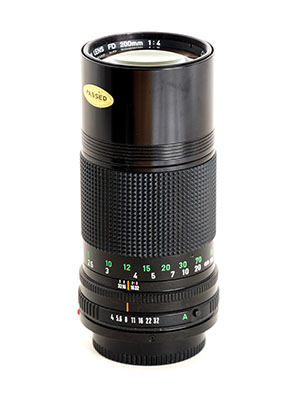
Status: Never used ourselves, some reliable information available.
- Very sharp across the frame from f/4 with moderate vignetting wide open.
- Since it is quite good from f/4 it gains only a little bit at smaller apertures.
- There is some axial Ca, the only real weakness of this lens
- Rather small and lightweight, easy to focus thank to IF.
Sharp, light, affordable: There is a lot to like about this lens, CA is the only shortcoming I see.
440g | $40 | aperture series | sample images
buy from ebay (affiliate link)
Canon nFD 4/300 L
Status: Part of Phillips setup for more than two years.
- At f/4 it is fully usable with very good sharpness across the frame, moderate vignetting and only a little CA. Bokeh is very good.
- From f/5.6 it is spectacular with excellent sharpness, very low CA and little vignetting
- Flare can be a problem
- At about 1kg it is neither small nor light but it is still small enough to put it into an average camera bag and handling on the a7 works well enough.
- Decent price/performance ratio.
- All in all a great lens but the price reflects that. Highly recommended.
1060g | $350 | full review | aperture series | sample images
buy from ebay (affiliate link)
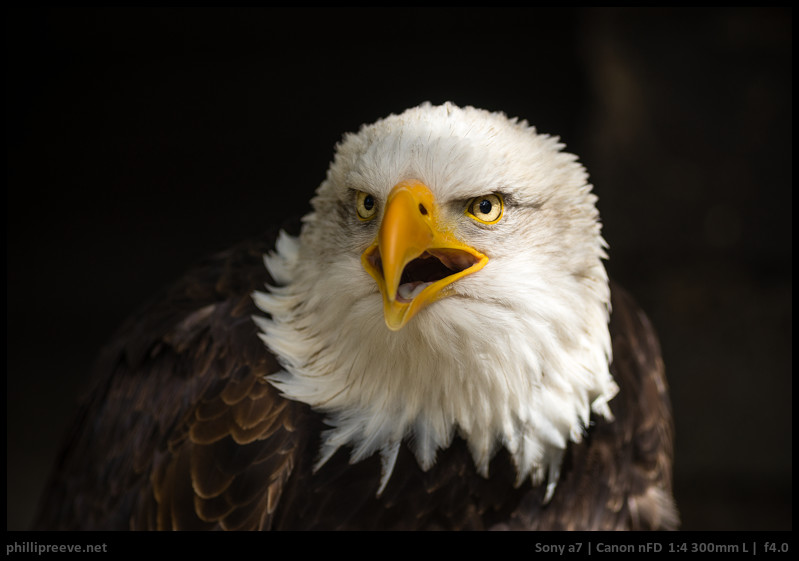
Thanks
A big thank you to:
- Micharl for providing test images for the 3.5/50 macro and 4/200 IF.
- Giovanni for providing images for the FD 4/17.
- Dan Noland for the nFD 2/24 samples and feedback on the list.
Still to come
The summaries for these lenses are in production
- nFD 2/28
- TS 2.8/35
- nFD 4/80-200 L
- nFD 5.6/100-300 L
Honorable mentions
We have no personal experience with these lenses but we have read positive reports about them from reliable sources. If you have full resolution images from them we are very interested :).
- nFD 2.8/20-35 L – As good or better as the 2.8/20 but bigger, more expensive and a longer short focusing distance.
- nFD 3.5/35-105 – not small but very good performance.
- nFD 2.8/100 – Small, affordable and quite a good performer by all reports
- nFD 1.8/200 L – super rare and expensive but it is by some margin the best lens in the system
- nFD 2.8/300 L – Excellent performance
- nFD 4.5/500 L (can have bearing issues) – Excellent performance
- nFD 4.5/50-300 L
Other articles
- Manual lenses on the Sony a7 – A beginners guide
- Affordable manual lenses for the Sony Alpha 7,7r,7ii,7rii and 7s
- Our reviews
Support Us
Did you find this article useful or just liked reading it? Treat us to a coffee!
![]()
![]()
![]() via Paypal
via Paypal
This site contains affiliate links. If you make a purchase using any of the links marked as affiliate links, I may receive a small commission at no additional cost to you. This helps support the creation of future content.
Latest posts by Phillip Reeve (see all)
- Review: Samyang AF 75/1.8 FE - April 12, 2021
- The FE-List now has 113 lenses on it - March 25, 2021
- 2020 – Year’s end review - December 28, 2020
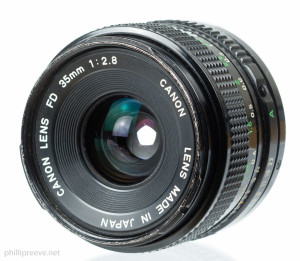
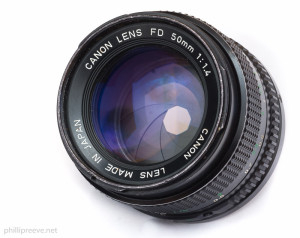

I can add:
The FD85L continues to amaze me. The L version can usually be had for $100 to $200 less than the older Apherical SSC version. I’ve had two and paid $500 for one of them and $550 for the other. The lens is equal in the center to the EF version and better than the EF version across the frame at basically all apertures. Considering there are only three existing designs for an 85mm f/1.2 and the other two (EF & Contax) sell for an upwards of $1200 (EF) to $2400 (Contax), $500 to $650 is a steal.
My experience is it’s optimized for head & shoulder portrait distances in terms of resolution. It’s an excellent landscape lens stopped down to f/8, too
The other FD lenses I have are the 135mm f/2 and the 20-35mm f/3.5L. You’re description of the 135mm is dead on. The 20-35mm is sharpest at 20mm and competitive in that regard with the 20mm f/2.8, but the mustache distortion make its almost impossible to use on anything with straight lines–the EF 17-40mm’s lens profile is the built in LR profile that works the best, but it isn’t perfect.
Hope that’s useful!
The FL SSC version has more blades too.
Thanks for this fantastic article, guys! I’ve got quite a few FD lenses in my collection thanks to all of you! One of which is the honorably mentioned 35-105/3.5. It’s my go to lens for video! I really like the focal length range and the macro function at the wide end. I’d be happy to take some photos for you!
Thanks again!
thanks for the offer Eric 🙂
Someone else already offered me some samples form that before you did, but if that doesn’t work out I will certainly contact you 🙂
There might be a few typos for aperture settings for the 80-200
I own the 50L and it is actually one of the smallest and lightest normal 1.2 lens for SLR. I am a lot more willing to carry that lens compared to Minolta 58 1.2.
FDn 50L is sharper wide open than the minolta 58 1.2 but 🙂 closed down for landscape this minolta is very sharp corner to corner even on 42mp. Most of the 1.2 lenses are soft and has a lot of CA in corners even closed down. The FDn 50L is on of the sharpest , but the minolta is CA-less at F8.0-11 and very very sharp. Wide open… a matter of taste. I like the Rokkor when it is cloudy and at night at some distances, the canon is different and also nice one, and sharper with better control over CA on wider apertures.
Hey, great to read an article about me beloved FD lenses. I did a writeup about the system, too.
http://vintage-lenses.blogspot.de/2016/02/best-canon-fd-lenses-to-consider.html
I can also provide some sample images if you want. I only keep the rarer ones, so some of them might be interesting. Right now I have:
24/1.4 L
35/2.8 TS
50/1.2 L
50/3.5 Macro
85/1.2 L
100/2
135/2
200/4 Macro
400/4.5
80-200/4 L
+ Bokina FD Mount
+ Voigtländer SL 75 2.5 FD Mount
I also shoot the on my T90 and F1 new
That’s a very solid list you have there.
I would be interested in samples of the 1.4/24 and 4.5/400. Just shoot me a mail at reeve.phillip@gmail.com. The easiest way for me would be if you uploaded them in full resolution to flickr and I would then add them to my collections.
Thanks
Phillip
Very good work Phillip, thanks for posting.
Hi Philip,
I am wondering if you didn’t have the FD 100 2.8 at your camera.
I own this lens and use it very often for portraits. From my opinion it’s already sharp at 2.8 and has a nice bokeh.
Hope you will get the chance to test it in the near future.
good question, added it to the list of lenses I will try to get my hand on one day 🙂
Hi Sabastian,
Do yourself a very big favour and buy a FD 100 f2. I used this lens in the 70s/80s on my trusty F1n (great camera) manly for sport, equestrian and motor cross where you needed to use slow ASA film to get pleasing images.
This lens even at f2 is stunning, amazingly sharp.
I sill use this lens on my x-pro 1, it is quite heavy compared to the 2.8, but worth its weight in gold.
Funny i had one and it sucked I guess I had a bad copy
Thanks for the great article and extensive testing. I would be curious what you think of the nFD 1.2/50 (non-L).
Haven’t used that one (yet), sorry.
For 300mm, the nFD 300/5.6 IF looks like a good budget-freindly choice:
http://forum.mflenses.com/comparison-canon-nfd-300-5-6-vs-minolta-md-300-4-5-t75798.html
*friendly
Looks quite good indeed, wasn’t aware of that one, thanks for pointing it out.
You should try and land a copy of the 35-70mm f4. It’s quite cheap, and in my comparisons with the MD 35-70mm f3.5 it was the sharper optic and the minimum focusing distance (in non-macro modes) was twice as close throughout the range. Definitely a good lens
sounds good. If I get one for cheap i will give it a try.
They run about $50 mint on eBay in the U.S., definitely an affordable lens
Phillip, thanks for linking to my review of the nFD 100 f2.
It’s definitely a great lens in an impressively small package.
Great FD guide, btw!
Hola Phillip Reeve, me parece muy interesante estos artículos.
Quiero comentar que tengo guardados algunos buenos canon fd, incluso el 14mm 2,8 L, lo ha probado o tiene referencias? también preguntarle si comprar la sony a7 o la a7 II, básicamente para usar estos canon fd y de otras marcas.
Gracias y un cordial saludo desde la Mancha, España.
Hi Phillip Reeve, I find these articles very interesting.
I want to comment that I have saved some good canon fd, even the 14mm 2.8 L, have you tried or have references? Also ask you if you buy the sony a7 or the a7 II, basically to use these canon fd and other brands.
Thank you and a cordial greeting from La Mancha, Spain.
Hi Miguel,
since the FD 2.8/14 is a rather exotic lens I didn’t get the chance to try one yet.
I probably wouldn’t buy a a7ii for the FDs but a a7? Yeah probably.
Phillip,
I tried both the canon FD 24 f/2 and f/2.8.
The FD 24 f/2 is quite a bit sharper in the center. However, it is softer than the f/2.8 in the corners.
Is this what you see too?
The olympus 24 f/2.8 has the best corner sharpness, but it cannot match FD 24 f/2’s center sharpness.
Thanks.
I’m interested in picking up an nFD 4/80-200 L for my a7ii. I see that this lens has been in your “still to come” list for a while now. Will you guys still be reviewing this lens? I know they are quite a bit different but, if you had to choose one, would you take an nFD 4/80-200 L or the nFD 4/300 L? I have found both for very good prices.
Thanks.
I liked the 4/80-200 L a lot because of it’s great CA correction but my copy wasn’t centered well so I found the corners a bit lacking and this seems to be a common theme with 80-200 lenses. So in the end I sold it and kept the 4/300 L which is faster to focus with better corners but less flexible and heavier.
I appreciate and enjoy your work! Thanks for making your articles and photos available!
You are welcome 🙂
Very nice blog, i enjoy reading about old FD lenses. Great research! Thanks!
You are welcome 🙂
Hi Phillip,
ich teste gerade das nFD 300 F4 an meine Sony A7S II. Vielleicht möchtest du dir die Bilder angucken. 🙂
https://flic.kr/s/aHsm55CvW5
Alles unberabeitet, nur in Lightroom importiert und exportiert.
Danke fürs Teilen. Da besteht zur L-Version doch ein sehr deutlicher Abstand.
Philip
I saw the pictures you posted a few years ago on flickr taken with a7 and canon fd 80 200 f4 l. They look very good to me and I am thinking of buying this lens for my a7ii. Do you recommend this lens? Any disadvantages? Is there a better lens than this at that price range?
Thank you and keep up the good work.
In the end I didn’t keep mine because it was a bit unwieldly and corners weren’t great. It worked well for poratrits and zoo visits but nowadays I carry the 4/300 L for that. Probably the lens which I am asked most often about. It is very sharp with excellent correction of axial CA/ bokeh fringing. If you can get it for a good price I would recommend it but don’t spend more than $200 on it. One alternative is the EF 4/70-200. I wouldn’t know a better legacy telezoom.
Thank you Philip for the nice pictures you share and for the reviews..
I have another question…I own a a7ii and have a canon fd 300 f4 l lens. I was looking to buy a canon fd 500 f4.5 l lens ..they are around one thousand dollars online. For that price i can buy a sony rx10iii in great shape. Would the 500mm or the rx10iii be more usefull for an amateur photographer like me?
I honestly don’t feel qualified to answer that question. I have experience with neither. I am sure that the FD has potentially higher IQ but only if you can stabilize and focus it well enough which will be much easier with the RX.
Thank you for this amazing resource! It helped me decided to shoot my short film on Canon FD lenses. Check out my short film which I shot on the Sony A7Rii + Canon FD.
https://vimeo.com/245405363
I used old Canon FD lenses for all the interior shots and for the water scenes I used the 35mm Sony / Carl Zeiss lens since it was the only auto focus lens that would fit in the underwater housing we had. I constantly switched back and forth from fullframe / super 35 mode – which is what I love about the A7Rii.
The whole film was shot using only natural light. For the interior scenes I mostly exposed from the window since that was my source of light. Because I created the look mostly in camera, it made color grading pretty hard…I used a custom color profile – one which I’m not sure if I would use again because the a lot of footage came out very purple-y… maybe it’s from the old canon glass?
Hi Phillip, just found your Blog … really great and helpful content for adapting old lenses on my A7II. I was searching for a review of the nFD 4/80-200 L and found this lens in your “Still to come –
The summaries for these lenses are in production” section. Are you still working on the review? When can we expect the article?
Probably not too soon to come since life happened.
Hi Phillip,
I’m come from Belgium and I hesitate to buy the Canon FD TS 35mm 2.8, would you recommend it? and why? Thank you for your reply.
I used to own one for maybe a year and it worked well. In the end I sold it because I had little use for a TS, not because I didn’t like the performance.
Hi Phillip,
Thanks again for you website to introduce those optical gems for us. Recently bought nFD 28mm 2.8 with nFD 50mm 1.8 together for 9 dollars while traveling (his previous owner thought they were broken, but I fixed their aperture rings just follow youtube video lol).
Haven’t test with the 50mm yet, but the 28mm really surprised me with the center sharpness in f 2.8 when testing on A7RIII. But one thing I have noticed is the corner sharpness didn’t really improve that much while step down (from f 5.6 to 11).
Also do you have any experience with mount issue of those FD lens? Mine seems block adapters if I fasten the last three screws first. My only solution now, is to attach adapter first then fasten those screws.
In my experience fitting the adapter can sometimes be a bit tricky but I have never fastened or unfastened a screw because of that.
Phillip,
So glad that the resource you put together here exists, its everything I want to know and none of what I dont. Well done\
What about the Canon FD 100mm F4 Macro?
Any experiences with this lense?
nope
Hi
I use it with a A7 /A7II and I find it a very good lens. However the optically best of the three FD macro lenses (50mm-100mm-200mm) is in my opinion the 200mm f/4 macro
Hi
excellent site and a wonderfully helpful resource; thank you.
My question is why the FD100f2.8 doesn’t rate a mention, its not that different to the f2 version is it? I have that lens but not the f2 so I can’t make any direct comparisons, however when I also had the Oly100f2.8 I had compared them (albeit on a GH1 so not the edges) and found that it was a very similar lens (although I do prefer the colour renditions of Olympus lenses)
Thanks in advance
Because I never owned one.
understood … are you interested in submitted reviews? (I understand if you are not)
So you didn’t compare it to other adapters?
At the moment I don’t have enough time to curate reviews.
Hi
I’m not sure I understand the first question of your reply, but I didn’t compare the OM100 to the FD100 because I used the OM100 on a 5D and there was no adapter for the FD100 (without an optic) to mount on the 5D. It is only recently I’ve moved to A7
I understand the second point you made well 😉
Hi Phillip,
wishing you a successful and happy new year. Thanks to you and the team for this wonderful pool of information.
I purchased the Novoflex Canon FD > Sony E through your link to mount my old lenses to my new Sony A7ii.
I do have an issue and I wonder if you could maybe point me into a direction of solving it.
While the 50mm FD lense is fine and the aperture changes are visible in the depth of field, my nFD 3.5/35-105 unfortunately does not seem to react to the aperture changes. All shots remain with blurry background, thus open aperture I guess, even with slow >f16. I tested the lense on my old AE-1 and peeked through using the depth of field preview slider and here I do see the change in the depth of field when changing the aperture.
Any tips are very welcome.
Thank you very much for your help in advance.
The issue is solved. I have not used the zoom for quite a while, so it seems that a pin for manual aperture adjustment on the lense was the problem and had to be moved back and forth a bit.
Great work. I have been reading for days.
I have a question, should I increase the sharpness or other settings in my a7 to get the most out of my fd 50 1.8?
Thank you
I would recommend to shoot raw and adjust by eye afterwards.
I am a big FDn series fan as I found them as most reliable with a great build.
In these reviews I noticed you don’t have a 28mm f2.
It is a rare lens (i am surprised it is), I was lucky to bump into one on garage sale.
The f2 might be a lure to get one but the lens is not so magnificent as you would think when you see the 200$ price tag on Ebay and rarely found. Shooting wide open at close distances is a joy with a bubble bokeh (if a rainy day and shiny drops make such effect) which is not often in Canon lenses. The good about the lens is that when you stop down to ideal f2.8 the bokeh circles are still circles, not pentagons, and with ideal sharpness. So using this lens for me ends at f2.8, everything after f2.8 is just mediocre sharpness with hell of a lot curvature in corners. The CA is not visible at most stops even on a sunny day which is a good side of the lens. For sure it has advantages over the 28mm f2.8 version.
Hi
I have a FDn 28mm F/2 and am very fond of it. It’s a very well balanced and harmonious lens, together with the FDn 35mm F/2 and the FDn 200mm F/4 macro is one of the most successful lenses of the FD line I own: I use them with the Sony 7/7II Alphas
Hey there! Firstly thanks for putting this guide together, it’s been so useful as I’ve built up my nFD set (24/2 + 28/2 + 35/2 + 50/1.4 +85/1.
I was wondering if you could help me out? I’m trying to work out if I’ve got a ‘good’ set. Basically I just want to know how consistent FD lenses are.
For example; if I’ve got a 24mm f/2, what’s the likelihood that I got a bad copy? I understand this is a common problem with vintage lenses in general, but as much as I’d like to buy a bunch of lenses to test and keep the best ones.. that’s a lot of money
It’s just tricky to know if the flaws I have with lenses (I.e. wider lenses having edge softness when wide open) are part of the lens design.. or a flaw of that individual copy.
I am a DP and use these lenses for shooting films and music videos. I want to invest in getting these lenses cine mod’ed but I’m just trying to get an idea of whether or not I need to go on a testing campaign.
Do you have any insights?
To say anything meaningful about copy to copy variation I would have had to vigorously test tens of copies of each lens which I obviously didn’t do. Variation is also an issue with many modern lenses where it is more obvious since these have sharp corners at wide apertures unlike most legacy lenses.
I can tell you that softer corners at wider apertures are to be expected from any of the lenses you mention.
I still have two lenses that I would call super. The FD 24/1.4 SSC and the FD 400/2.8L. Use them on the F1, I still shoot film with these. Have zero interest to hook them up to digital, I have the same lenses in EF for digital and analog: 1N-RS.
nFD 5.6/100-300 L on a Sony a6500 is it good?
It isn’t a very good lens at the long end and ergonomics are difficult. Not recommended unless you get i5 for a very good price.
I’m pretty late to the party, and I don’t know if this is where I can ask questions, but I recently bought from eBay nfd 28mm/f2.8 to use with a7ii, but every picture I take is wide open and when I turn the aperture ring on the lens without the camera body itself I don’t see aperture blades closing or widening. Did I purchase a defective lens?
Have you successfully used other FD lenses? mounting them is a bit tricky and if you do it wrong or don’t mount the adapter you see the symptoms you describe.
Hello Phillip,
Any idea why 100mm f/2 shot up in price so much lately?
It is one of my all-time favorite lenses, so naturally I own 2 of them 🙂
And I was bewildered to discovered that they are now commanding 1.5k-2.5k on ebay and keh, especially since I purchased mine for under $150.
People are bored during Covid and don’t know what to spend their money on so they start collecting things.
That’s totally crazy in my eyes!
I have a canon FD to Minolta/Sony A mount adapter which is stuck on my Minolta A-9 Dynax camera,the FD lens attaches and removes on the adapter,but the adapter is stuck on the camera,any advice on how to remove it will be greatly appreciated
No idea, sorry 🙁
Some remarks for those who have trouble with their mount converter on infinity.
1. Please be aware that the sharpness accuracy of the focal distance in your camera is in the order of microns (1/1000 of a mm or 4/1000 of an inch). So very small particles on the flanges may make it impossible to get your picture sharp at infinity. The actual situation is that with a mount converter you will have two flange connections, one between camera brand and converter and the other between lens brand and converter. In the original situation you only have one such connection between camera and lens of the same brand. You will easily have very small errors in the order of microns introduced here.
What helped for me is to clean all four flanges with so-called “hand-alcohol” before connecting the mount converter.
2. Another issue might be that for long distances at infinity the number of pixels is no longer available for sharp pictures. The reason is that for recognizing a structure you will need 10-12 pixels on that structure (You may try out by making pictures of letters or figures with a 24mm lens at distances of a few meters, you will easily find that with less than 10 pixels per letter, that letter will be distorted!).
Hope this may be of help.
I have a Cannon FL 135 F2.5 that I like a lot. I think there is an FD version with the same glass that is probably easier to use. If I am not careful I end up shooting wide open because I forget to check the preset ring.